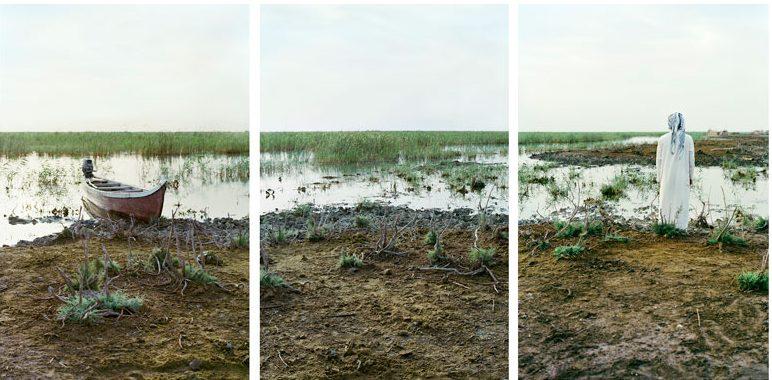The marshes in southern Iraq, formed by the Tigris and Euphrates Rivers, are home to one of humanity’s oldest cultures, once the third-largest wetlands in the world. The Eden In Iraq wastewater garden project started as a humanitarian project that has developed as a necessity for the people of Al Chibaish and the localities surrounding the town. This water remediation project holistically looks at wastewater, trying to include this type of water and its nutrients in a sustainable form by using it to create green spaces. The Eden project in Iraq regards human waste as a valuable source of nutrients and freshwater, which can add to local greenery and landscape beauty if properly treated close to its source. From a climate change point of view, the project focuses on the creation of a wetland with wastewater that can support a garden within the marshes of Iraq. Marsh restoration is a powerful tool against warming temperatures and loss of vegetation, especially in arid areas such as Iraq. From a biodiversity point of view, the project bares a great deal of significance as marshes support a myriad of rare wildlife and rich biodiversity. (1,2,3)
Overview
Nature-based solution
- Blue infrastructure
- In-land wetlands, peatlands, swamps, and moors
- Parks and urban forests
- Other
Key challenges
- Climate action for adaptation, resilience and mitigation (SDG 13)
- Climate change adaptation
- Green space, habitats and biodiversity (SDG 15)
- Habitat and biodiversity conservation
- Green space creation and/or management
- Water management (SDG 6)
- Stormwater and rainfall management and storage
- Improvements to water quality
- Cultural heritage and cultural diversity
- Preservation of natural heritage
- Protection of historic and cultural landscape/infrastructure
Focus
Project objectives
Implementation activities
Climate-focused activities
Climate change adaptation:
- Implement measures that prevent/manage desertification, soil erosion and landslides
- Implement solutions to capture/store water to increase its availability and prevent shortages from droughts
- Increase or improve urban vegetation cover to help reduce outdoor temperature
- Restore wetlands and/or coastal ecosystems to dissipate the effects of flooding and/or storms
Biodiversity conservation or restoration-focused activities
Biodiversity conservation:
- Protect and enhance urban habitats
- Preserve and strengthen existing habitats and ecosystems
- Protect species
- Undertake specific measures to protect species
- Undertake specific measures to protect native species
- Undertake specific measures to protect endangered species
- Means for conservation governance
- Raise public awareness
- Public engagement
Main beneficiaries
- Citizens or community groups
- Marginalized groups: Socio-economically disadvantaged populations (e.g. low-income households, unemployed)
Governance
Management set-up
- Co-governance with government and non-government actors
Type of initiating organisation
- Non-government organisation/civil society
- Researchers/university
Participatory approaches/ community involvement
- Co-planning (e.g. stakeholder workshops, focus groups, participatory mapping)
- Crowd-sourcing/Crowd-funding/Participatory budget
- Dissemination of information and education
- Consultation (e.g. workshop, surveys, community meetings, town halls)
Details on the roles of the organisations involved in the project
Project implemented in response to ...
Financing
Total cost
Source(s) of funding
- Crowdfunding
Type of funding
- Donations
Non-financial contribution
Impacts and Monitoring
Environmental impacts
- Climate change
- Enhanced carbon sequestration
- Environmental quality
- Improved air quality
- Water management and blue areas
- Improved water quality
- Green space and habitat
- Increased green space area
- Reduced biodiversity loss
- Increased number of species present
Economic impacts
- Generation of income from NBS
Socio-cultural impacts
- Cultural heritage and sense of place
- Protection of natural heritage
- Protection of historic and cultural landscape / infrastructure
Type of reported impacts
Presence of formal monitoring system
Presence of indicators used in reporting
Presence of monitoring/ evaluation reports
Availability of a web-based monitoring tool
References
2. Meridel Rubenstein Studio (no date), Website of the artist, available at Source link (accessed 28-03-2022)
3. Nature in Iraq, EchoTechnics (no date), EDEN IN IRAQ: The Wastewater Garden Project. Ecological and Cultural Restoration in the Mesopotamian Marshes, available at Source link (accessed 28-03-2022)
4. Unesco Green Citizens (no date), Eden in Iraq WasteWater Garden Project, available at Source link (accessed 28-03-2022)
5. Eden in Iraq Website (no date), available at Source link (accessed 28-03-2022)
6. Dr. Mark Nelson, PhD Dr. Davide Tocchetto, PhD Institute of Ecotechnics/Wastewater Gardens International Wastewater Gardens International (2014), EDEN IN IRAQ Al-Manar Project - Environmental Impact Assessment- attached.




